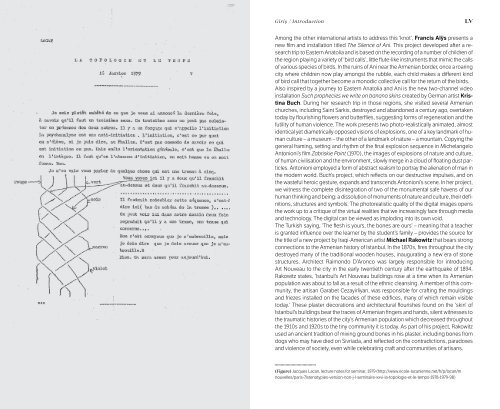TUZLU SU SALTWATER
14B_Catalogue
14B_Catalogue
- No tags were found...
Create successful ePaper yourself
Turn your PDF publications into a flip-book with our unique Google optimized e-Paper software.
LIV<br />
Carolyn Christov-Bakargiev<br />
Giriş / Introduction<br />
LV<br />
Among the other international artists to address this ‘knot’, Francis Alÿs presents a<br />
new film and installation titled The Silence of Ani. This project developed after a research<br />
trip to Eastern Anatolia and is based on the recording of a number of children of<br />
the region playing a variety of ‘bird calls’, little flute-like instruments that mimic the calls<br />
of various species of birds. In the ruins of Ani near the Armenian border, once a roaring<br />
city where children now play amongst the rubble, each child makes a different kind<br />
of bird call that together become a monodic collective call for the return of the birds.<br />
Also inspired by a journey to Eastern Anatolia and Ani is the new two-channel video<br />
installation Such prophecies we write on banana skins created by German artist Kristina<br />
Buch. During her research trip in those regions, she visited several Armenian<br />
churches, including Saint Sarkis, destroyed and abandoned a century ago, overtaken<br />
today by flourishing flowers and butterflies, suggesting forms of regeneration and the<br />
futility of human violence. The work presents two photo-realistically animated, almost<br />
identical yet diametri cally opposed visions of explosions, one of a key landmark of human<br />
culture – a museum – the other of a landmark of nature – a mountain. Copying the<br />
general framing, setting and rhythm of the final explosion sequence in Michelangelo<br />
Antonioni’s film Zabriskie Point (1970), the images of explosions of nature and culture,<br />
of human civilisation and the environment, slowly merge in a cloud of floating dust particles.<br />
Antonioni employed a form of abstract realism to portray the alienation of man in<br />
the mod ern world. Buch’s project, which reflects on our destructive impulses, and on<br />
the wasteful heroic gesture, expands and transcends Antonioni’s scene. In her project,<br />
we witness the complete disintegration of two of the monumental safe havens of our<br />
human thinking and being: a dissolution of monuments of nature and culture, their definitions,<br />
structures and symbols. The photorealistic quality of the digital images opens<br />
the work up to a critique of the virtual realities that we increasingly face through media<br />
and technology. The digital can be viewed as imploding into its own void.<br />
The Turkish saying, ‘The flesh is yours, the bones are ours’ – meaning that a teacher<br />
is granted influence over the learner by the student’s family – provides the source for<br />
the title of a new project by Iraqi-American artist Michael Rakowitz that bears strong<br />
connections to the Armenian history of Istanbul. In the 1870s, fires throughout the city<br />
destroyed many of the traditional wooden houses, inaugurating a new era of stone<br />
structures. Architect Raimondo D’Aronco was largely responsible for introducing<br />
Art Nouveau to the city in the early twentieth century after the earthquake of 1894.<br />
Rakowitz states, ‘Istanbul’s Art Nouveau buildings rose at a time when its Armenian<br />
population was about to fall as a result of the ethnic cleansing. A member of this community,<br />
the artisan Garabet Cezayirliyan, was responsible for crafting the mouldings<br />
and friezes installed on the facades of these edifices, many of which remain visible<br />
today.’ These plaster decorations and architectural flourishes found on the ‘skin’ of<br />
Istanbul’s buildings bear the traces of Armenian fingers and hands, silent witnesses to<br />
the traumatic histories of the city’s Armenian population which decreased throughout<br />
the 1910s and 1920s to the tiny community it is today. As part of his project, Rakowitz<br />
used an ancient tradition of mixing ground bones in his plaster, including bones from<br />
dogs who may have died on Sivriada, and reflected on the contradictions, paradoxes<br />
and violence of society, even while celebrating craft and communities of artisans.<br />
(Figure) Jacques Lacan, lecture notes for seminar, 1979 (http://www.ecole-lacanienne.net/fr/p/lacan/m<br />
nouvelles/paris-7/stenotypies-version-non-j-l-seminaire-xxvi-la-topologie-et-le-temps-1978-1979-98)


